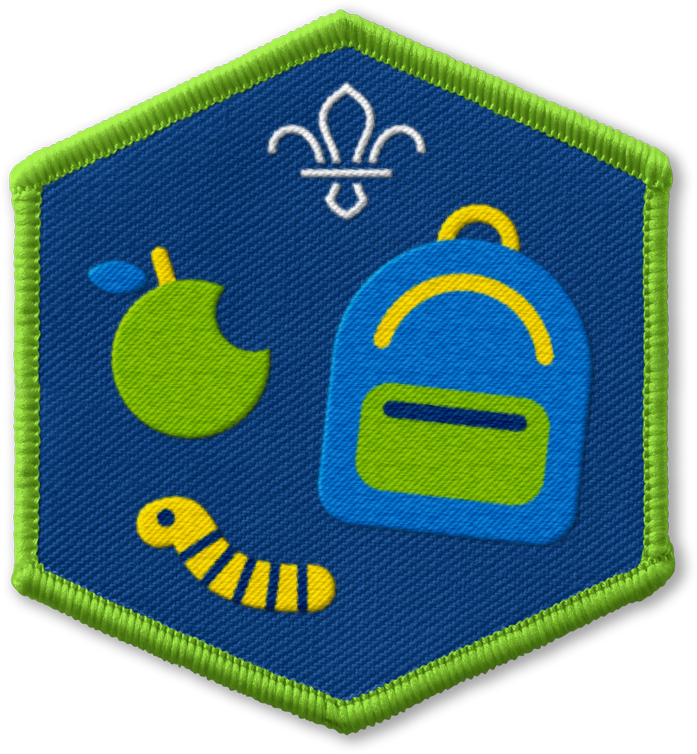
Learn how to pitch a tent
You’ll need
- A tent
Before you begin
- Use the safety checklist to help you plan and risk assess your activity. Additional help to carry out your risk assessment.
- Make sure all young people and adults involved in the activity know how to take part safely.
- Make sure you’ll have enough adult helpers. You may need some parents and carers to help if you’re short on helpers.
Setting up this activity
- Decide how you’ll run this activity – you may want to run it as one base during a camp themed session.
- If you have a larger group, you may need to find some extra tents and divided the group into smaller teams.
- Find an outdoor space to put up the tent. You can do it indoors if you need to. You’ll just get some heavy books, sandbags or stones to weigh down the guy ropes.
- Before the session, unpack the tent, and separate it into its parts – the inner, the outer, poles, pegs, and mallet.
- You could print copies of the ‘Teach me about tents’ sheet to help people or to chat through what each part is.
Explore tent parts
- Gather everyone together and tell people you’re going to learn more about putting up a tent.
- Ask everyone to get into small groups of three or four people.
- Ideally you want four or five groups, depending on whether you leave the mallet with the pegs or have it as its own separate item.
- Give each group a tent part.
- Each group should spend a minute or two talking about their tent part. They could use the ‘Teach me about tents’ sheet to help them, or a volunteer could chat to each group about what their part is called, what it does, and where it fits in the tent.
- For younger groups, after a minute or two, everyone should put their tent part on the floor. Each group should move around the space in the same direction, so they get a chance to explore the next tent part. Keep repeating this and moving on until everyone’s explored each tent part.
- For older groups, you may want to talk through all the tent parts or let people talk through the tent part they have.
Pitch the tent
- Each group should return to the tent part they looked at first.
- Ask which part of the tent everyone thinks is the first one needed to pitch the tent.
- Now, let everyone work together to pitch the tent, following any specific instructions on the tent they’re working with.
- Usually, the first step is for everyone to lay out the inner or outer tent (whatever the poles go through). Make sure all the doors are zipped up.
- The group with the poles should assemble them, and work with the group with the inner or outer to thread the poles through the sleeves in the tent. Everyone should be careful not to tear the fabric.
- You may need to help everyone understand how the poles fit together. They should be pushed, not pulled, so they don’t come apart.
- Everyone should find the connectors on the inner or outer tent, and put them into the ends of the poles. They may look like plastic or metal keys – when they’re put into the poles, they help raise the tent.
- Everyone should attach the inner or outer tent to whichever part they’ve already assembled.
- Everyone should peg out the tent, starting with the loops closest to the tent canvas. They should make sure the pegs point at an angle away from the tent.
- If the pegs need to be hammered with a mallet, an adult should do this safely.
- Everyone should peg out the guy lines. They should be tight, and they should follow the line of the seam they’re attached to.
- Now the tent is pitched, everyone should walk around it to check everything’s in the right place. Does anything look wonky? Are there any unpegged guy ropes?
- Everyone can take it in turns to sit or lay in the tent. What do they think of it?
- Now, have a chat about good tent practice – what do people think they should do? People should take their shoes off before you go in and not poke the fabric, especially from the inside!
- Once everyone’s explored the tent, everyone should work together to take it down. This is called striking the tent. They should clean any parts that need cleaning, then fold the tent, and put it away safely.
Reflection
This activity was a chance for everyone to develop skills. Can everyone work together to remember the different steps? Did people find any steps especially tricky?
People may say fiddlier tasks, such as threading the poles through, or getting connectors into the ends of the poles. Do people think it would be easier to pitch a tent alone, or with a group of friends?
Ask if anyone can remember any new words they’ve learned today, such as pitch, strike, poles, guy lines, pegs, and mallet.
This activity also needed everyone to work in a team. How did people work with their teammates to make sure they pitched their tent as well as they could? How did you make sure it was fair and everyone got to try? How did you help each other or use each other’s skills?
Communication is a really important part of teamwork. Were people’s teams good at listening to each other? How did people make sure they were heard, as well as listening to others? Is there anything people would do differently next time they pitch a tent?
Safety
All activities must be safely managed. You must complete a thorough risk assessment and take appropriate steps to reduce risk. Use the safety checklist to help you plan and risk assess your activity. Always get approval for the activity, and have suitable supervision and an InTouch process.
- Outdoor activities
You must have permission to use the location. Always check the weather forecast, and inform parents and carers of any change in venue.
- Poles and long objects
Be careful when moving poles or long items. Take care if the ends are sharp. Have appropriate supervision for this activity.
- Heavy and awkward objects
Never lift or move heavy or awkward items alone. Ask for help or, if possible, break them down into smaller parts.
Encourage everyone to work a team and do as much as they can independently.
You could label the parts in ‘Explore tent parts’ to give people an extra clue.
Change the size of groups for ‘Explore tent parts’, for example by putting labelled parts around the space and asking people to move around in pairs. Anyone who can’t help as much with the physical aspects of pitching a tent can still contribute by instructing and helping others – a lot of the time not everyone needs to be touching or moving the tent anyway.
All Scout activities should be inclusive and accessible.
Pitch a group of tents near your meeting space and enjoy a camp experience together. You could build a campfire, play games, or do a quieter activity like storytelling in the tents. Why not add some soft furnishings, such as cushions and soft toys, to make the tents more homely? Remember, if you do this activity while on a sleepover or camp, it could count towards your My Outdoors Challenge Award.





